Auditing and Assurance: Reviewing Financial Statement Integrity
VerifiedAdded on 2023/04/24
|18
|2795
|186
Homework Assignment
AI Summary
This assignment solution covers various aspects of auditing and assurance, including ethical considerations, financial statement analysis, and fraud detection. It addresses specific questions related to auditor responsibilities, transaction-related audit objectives, and the reliability of different types of audit evidence. The solution also explores analytical procedures for enhancing audit quality and provides insights into potential misstatements and fraud risks within financial reports. Key areas covered include the assessment of internal controls, the confirmation of account balances, and the importance of independent evidence in forming audit opinions. The document provides detailed explanations and examples, offering a comprehensive understanding of auditing principles and practices. Desklib offers a platform for students to access similar solved assignments and past papers.
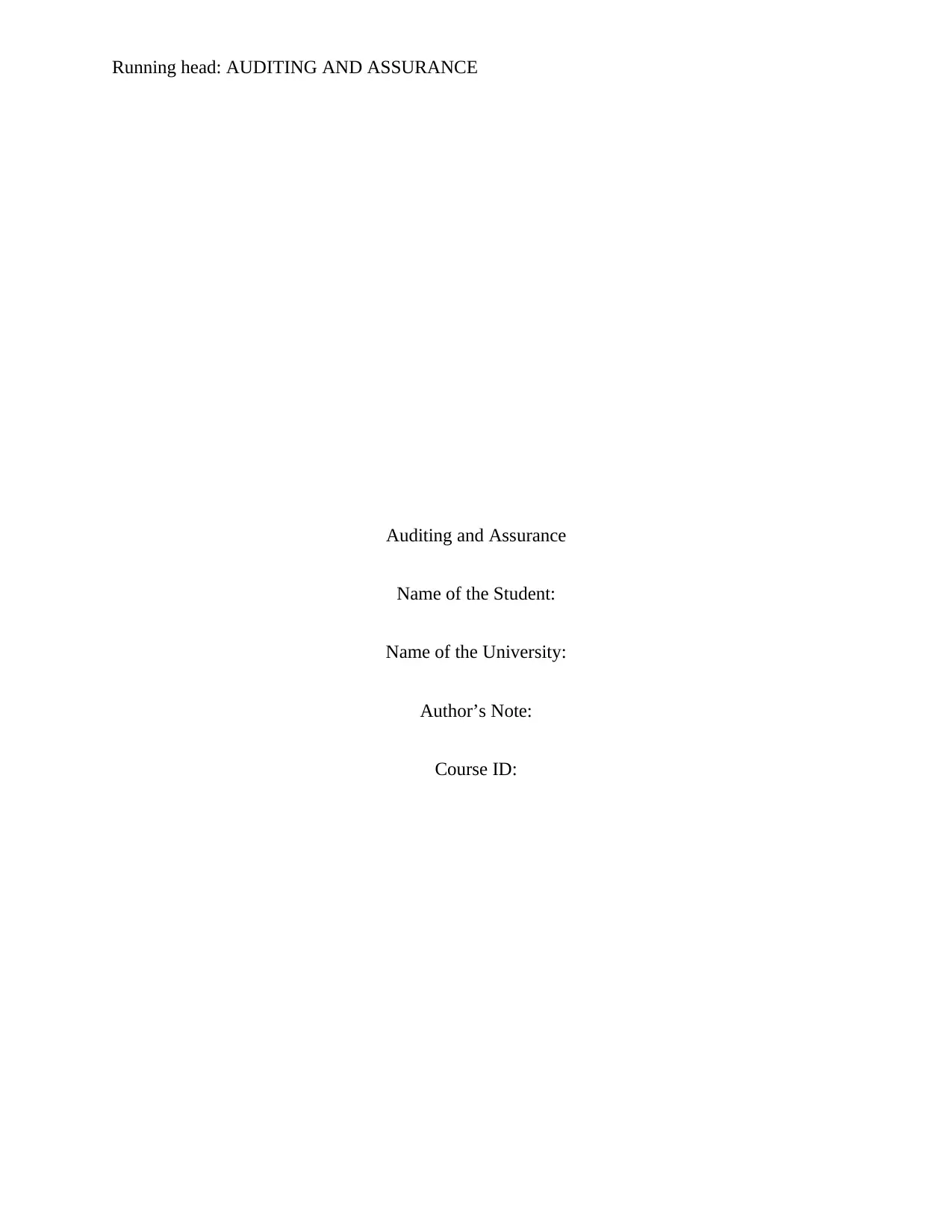
Running head: AUDITING AND ASSURANCE
Auditing and Assurance
Name of the Student:
Name of the University:
Author’s Note:
Course ID:
Auditing and Assurance
Name of the Student:
Name of the University:
Author’s Note:
Course ID:
Paraphrase This Document
Need a fresh take? Get an instant paraphrase of this document with our AI Paraphraser

1AUDITING AND ASSURANCE
Table of Contents
Question 5-23:.................................................................................................................................3
Requirement a:.............................................................................................................................3
Requirement b:.............................................................................................................................3
Requirement c:.............................................................................................................................3
Question 5-24:.................................................................................................................................3
Requirement 1:.............................................................................................................................3
Requirement 2:.............................................................................................................................4
Requirement 3:.............................................................................................................................4
Requirement 4:.............................................................................................................................4
Requirement 5:.............................................................................................................................4
Requirement 6:.............................................................................................................................4
Question 6-23:.................................................................................................................................4
Requirement a:.............................................................................................................................4
Requirement b:.............................................................................................................................4
Requirement c:.............................................................................................................................5
Question 6-27:.................................................................................................................................5
Requirement a:.............................................................................................................................5
Requirements b and c:.................................................................................................................6
Table of Contents
Question 5-23:.................................................................................................................................3
Requirement a:.............................................................................................................................3
Requirement b:.............................................................................................................................3
Requirement c:.............................................................................................................................3
Question 5-24:.................................................................................................................................3
Requirement 1:.............................................................................................................................3
Requirement 2:.............................................................................................................................4
Requirement 3:.............................................................................................................................4
Requirement 4:.............................................................................................................................4
Requirement 5:.............................................................................................................................4
Requirement 6:.............................................................................................................................4
Question 6-23:.................................................................................................................................4
Requirement a:.............................................................................................................................4
Requirement b:.............................................................................................................................4
Requirement c:.............................................................................................................................5
Question 6-27:.................................................................................................................................5
Requirement a:.............................................................................................................................5
Requirements b and c:.................................................................................................................6

2AUDITING AND ASSURANCE
Question 11-30:...............................................................................................................................6
Question 7-27:.................................................................................................................................7
Requirement a:.............................................................................................................................7
Requirement b:.............................................................................................................................8
Question 7-30:.................................................................................................................................9
Requirement a:.............................................................................................................................9
Requirement b:.............................................................................................................................9
Requirement c:.............................................................................................................................9
Requirement d:.............................................................................................................................9
Requirement e:.............................................................................................................................9
Requirement f:...........................................................................................................................10
Requirement g:...........................................................................................................................10
Question 7-31:...............................................................................................................................11
Question 8-22:...............................................................................................................................13
Question 8-33:...............................................................................................................................13
Requirement a:...........................................................................................................................13
Requirement b:...........................................................................................................................14
Question 9-33:...............................................................................................................................14
References:....................................................................................................................................16
Question 11-30:...............................................................................................................................6
Question 7-27:.................................................................................................................................7
Requirement a:.............................................................................................................................7
Requirement b:.............................................................................................................................8
Question 7-30:.................................................................................................................................9
Requirement a:.............................................................................................................................9
Requirement b:.............................................................................................................................9
Requirement c:.............................................................................................................................9
Requirement d:.............................................................................................................................9
Requirement e:.............................................................................................................................9
Requirement f:...........................................................................................................................10
Requirement g:...........................................................................................................................10
Question 7-31:...............................................................................................................................11
Question 8-22:...............................................................................................................................13
Question 8-33:...............................................................................................................................13
Requirement a:...........................................................................................................................13
Requirement b:...........................................................................................................................14
Question 9-33:...............................................................................................................................14
References:....................................................................................................................................16
⊘ This is a preview!⊘
Do you want full access?
Subscribe today to unlock all pages.

Trusted by 1+ million students worldwide
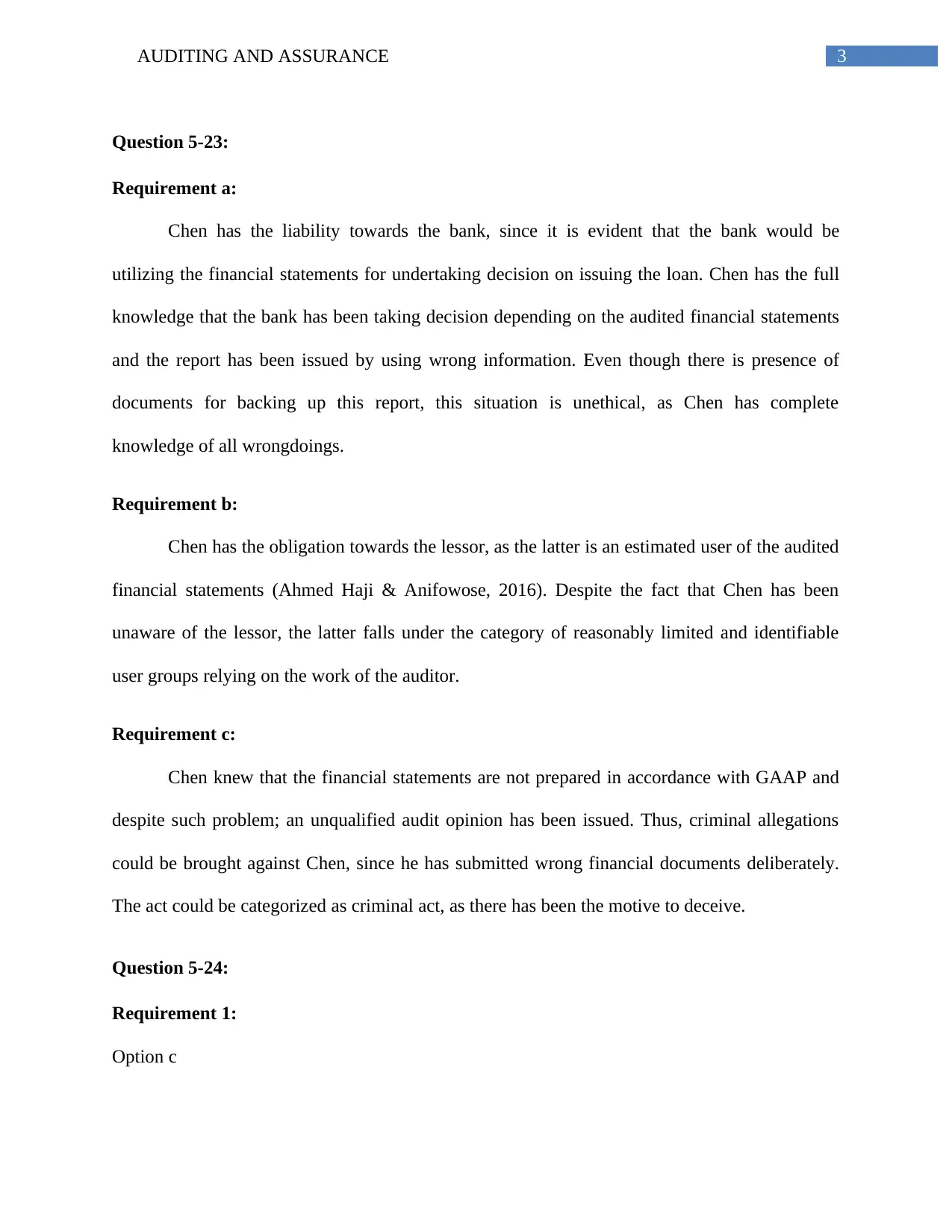
3AUDITING AND ASSURANCE
Question 5-23:
Requirement a:
Chen has the liability towards the bank, since it is evident that the bank would be
utilizing the financial statements for undertaking decision on issuing the loan. Chen has the full
knowledge that the bank has been taking decision depending on the audited financial statements
and the report has been issued by using wrong information. Even though there is presence of
documents for backing up this report, this situation is unethical, as Chen has complete
knowledge of all wrongdoings.
Requirement b:
Chen has the obligation towards the lessor, as the latter is an estimated user of the audited
financial statements (Ahmed Haji & Anifowose, 2016). Despite the fact that Chen has been
unaware of the lessor, the latter falls under the category of reasonably limited and identifiable
user groups relying on the work of the auditor.
Requirement c:
Chen knew that the financial statements are not prepared in accordance with GAAP and
despite such problem; an unqualified audit opinion has been issued. Thus, criminal allegations
could be brought against Chen, since he has submitted wrong financial documents deliberately.
The act could be categorized as criminal act, as there has been the motive to deceive.
Question 5-24:
Requirement 1:
Option c
Question 5-23:
Requirement a:
Chen has the liability towards the bank, since it is evident that the bank would be
utilizing the financial statements for undertaking decision on issuing the loan. Chen has the full
knowledge that the bank has been taking decision depending on the audited financial statements
and the report has been issued by using wrong information. Even though there is presence of
documents for backing up this report, this situation is unethical, as Chen has complete
knowledge of all wrongdoings.
Requirement b:
Chen has the obligation towards the lessor, as the latter is an estimated user of the audited
financial statements (Ahmed Haji & Anifowose, 2016). Despite the fact that Chen has been
unaware of the lessor, the latter falls under the category of reasonably limited and identifiable
user groups relying on the work of the auditor.
Requirement c:
Chen knew that the financial statements are not prepared in accordance with GAAP and
despite such problem; an unqualified audit opinion has been issued. Thus, criminal allegations
could be brought against Chen, since he has submitted wrong financial documents deliberately.
The act could be categorized as criminal act, as there has been the motive to deceive.
Question 5-24:
Requirement 1:
Option c
Paraphrase This Document
Need a fresh take? Get an instant paraphrase of this document with our AI Paraphraser

4AUDITING AND ASSURANCE
Requirement 2:
Option c
Requirement 3:
Option d
Requirement 4:
Option d
Requirement 5:
Option b
Requirement 6:
Option b
Question 6-23:
Requirement a:
Reasonable assurance could be identified as greater assurance level, which is denoted by
the auditing standards. The users need to contain increased degree of confidence in the financial
reports. Reasonable assurance is an absolute assurance level, since there are some minimum risks
that there might be material misstatements in the audited financial reports (Chambers & Odar,
2015).
Requirement b:
The independent auditors have the responsibility to provide an opinion on the audited
financial reports. Thus, they are needed to check the adequacy and accuracy of the financial
statements by adhering to the necessary auditing standards based on which they should provide
Requirement 2:
Option c
Requirement 3:
Option d
Requirement 4:
Option d
Requirement 5:
Option b
Requirement 6:
Option b
Question 6-23:
Requirement a:
Reasonable assurance could be identified as greater assurance level, which is denoted by
the auditing standards. The users need to contain increased degree of confidence in the financial
reports. Reasonable assurance is an absolute assurance level, since there are some minimum risks
that there might be material misstatements in the audited financial reports (Chambers & Odar,
2015).
Requirement b:
The independent auditors have the responsibility to provide an opinion on the audited
financial reports. Thus, they are needed to check the adequacy and accuracy of the financial
statements by adhering to the necessary auditing standards based on which they should provide

5AUDITING AND ASSURANCE
their opinion. At the time of representing in the form of independent auditors, they need to
possess the capabilities of being qualified individuals in the profession. Such qualities do not
include appraiser, insurer, lawyer or expert in materials.
Requirement c:
An auditor is liable to gain reasonable assurance that significant misstatements engaged
in the statement are identified to find out whether they are due to errors or frauds. More
precisely, frauds are difficult to be detected than errors, since the management or staffs
conducting fraud would try to conceal the same; however, the auditor has to overcome this
difficulty at the time of planning the audit process.
The auditor needs to uncover situations when audits are performed leading to doubts or
fraudulent financial reporting. The auditor generally analyses the chance of considerable
misappropriation of assets as a part of insight of internal control along with analyzing control
risk. The evidences need to be described at the time the auditor fails to comply with the
necessary guidelines or to consider substantial fraud (Christensen, Glover & Wolfe, 2014).
Question 6-27:
Requirement a:
General transaction-related audit objectives:
These objectives assist in providing a detailed structure through which the auditors could
gather competent evidence. The auditors formulate audit objectives after the management
assertions are identified appropriately. These objectives have close relationships with
management assertions.
Management assertions about classes of transactions and events:
their opinion. At the time of representing in the form of independent auditors, they need to
possess the capabilities of being qualified individuals in the profession. Such qualities do not
include appraiser, insurer, lawyer or expert in materials.
Requirement c:
An auditor is liable to gain reasonable assurance that significant misstatements engaged
in the statement are identified to find out whether they are due to errors or frauds. More
precisely, frauds are difficult to be detected than errors, since the management or staffs
conducting fraud would try to conceal the same; however, the auditor has to overcome this
difficulty at the time of planning the audit process.
The auditor needs to uncover situations when audits are performed leading to doubts or
fraudulent financial reporting. The auditor generally analyses the chance of considerable
misappropriation of assets as a part of insight of internal control along with analyzing control
risk. The evidences need to be described at the time the auditor fails to comply with the
necessary guidelines or to consider substantial fraud (Christensen, Glover & Wolfe, 2014).
Question 6-27:
Requirement a:
General transaction-related audit objectives:
These objectives assist in providing a detailed structure through which the auditors could
gather competent evidence. The auditors formulate audit objectives after the management
assertions are identified appropriately. These objectives have close relationships with
management assertions.
Management assertions about classes of transactions and events:
⊘ This is a preview!⊘
Do you want full access?
Subscribe today to unlock all pages.

Trusted by 1+ million students worldwide
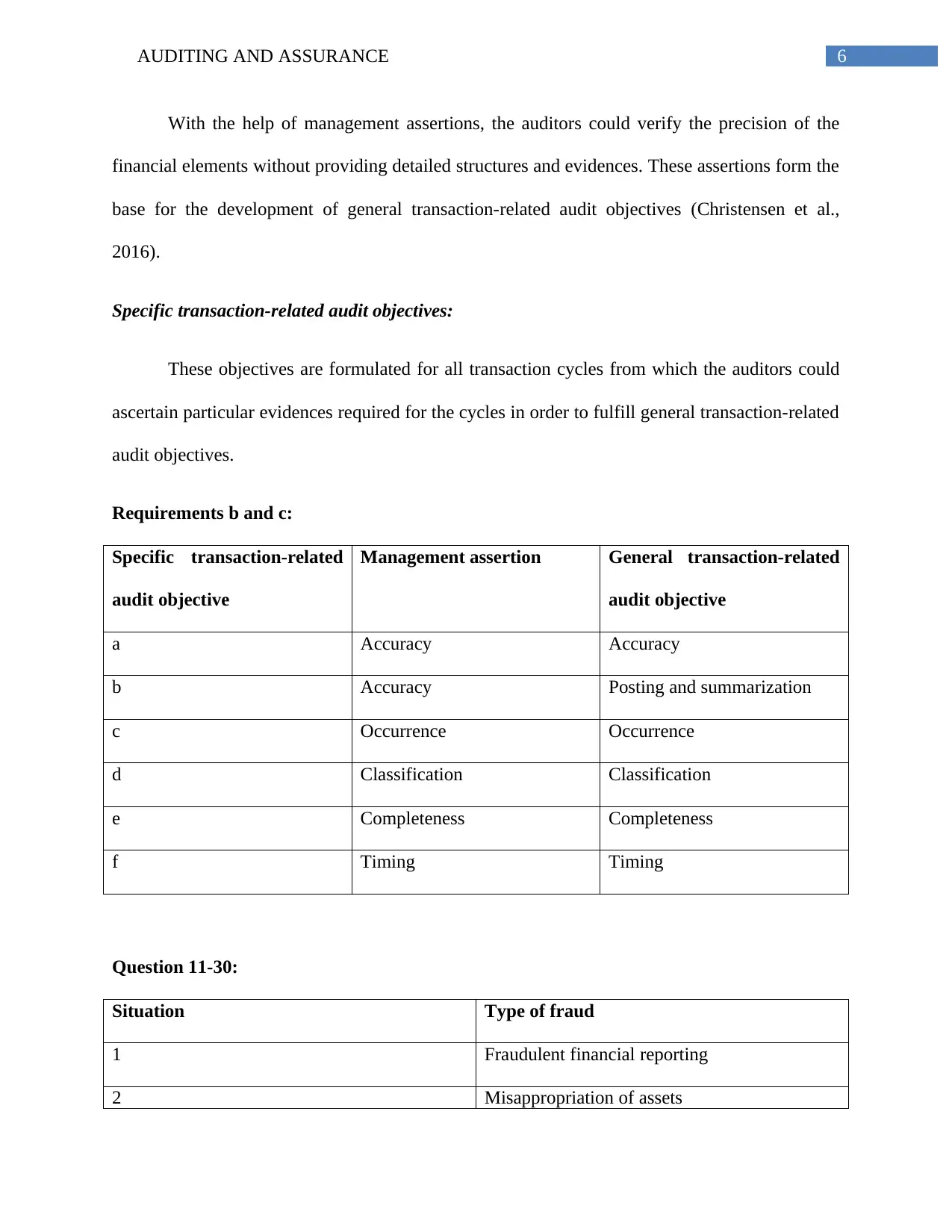
6AUDITING AND ASSURANCE
With the help of management assertions, the auditors could verify the precision of the
financial elements without providing detailed structures and evidences. These assertions form the
base for the development of general transaction-related audit objectives (Christensen et al.,
2016).
Specific transaction-related audit objectives:
These objectives are formulated for all transaction cycles from which the auditors could
ascertain particular evidences required for the cycles in order to fulfill general transaction-related
audit objectives.
Requirements b and c:
Specific transaction-related
audit objective
Management assertion General transaction-related
audit objective
a Accuracy Accuracy
b Accuracy Posting and summarization
c Occurrence Occurrence
d Classification Classification
e Completeness Completeness
f Timing Timing
Question 11-30:
Situation Type of fraud
1 Fraudulent financial reporting
2 Misappropriation of assets
With the help of management assertions, the auditors could verify the precision of the
financial elements without providing detailed structures and evidences. These assertions form the
base for the development of general transaction-related audit objectives (Christensen et al.,
2016).
Specific transaction-related audit objectives:
These objectives are formulated for all transaction cycles from which the auditors could
ascertain particular evidences required for the cycles in order to fulfill general transaction-related
audit objectives.
Requirements b and c:
Specific transaction-related
audit objective
Management assertion General transaction-related
audit objective
a Accuracy Accuracy
b Accuracy Posting and summarization
c Occurrence Occurrence
d Classification Classification
e Completeness Completeness
f Timing Timing
Question 11-30:
Situation Type of fraud
1 Fraudulent financial reporting
2 Misappropriation of assets
Paraphrase This Document
Need a fresh take? Get an instant paraphrase of this document with our AI Paraphraser

7AUDITING AND ASSURANCE
3 Fraudulent financial reporting
4 Misappropriation of assets
5 Fraudulent financial reporting
6 Misappropriation of assets
Question 7-27:
Requirement a:
Item number Type of documentation
1 External
2 Internal
3 External
4 External
5 Internal
6 Internal
7 Internal
8 Internal
9 External
10 Internal
11 External
12 External
13 Internal
14 External
3 Fraudulent financial reporting
4 Misappropriation of assets
5 Fraudulent financial reporting
6 Misappropriation of assets
Question 7-27:
Requirement a:
Item number Type of documentation
1 External
2 Internal
3 External
4 External
5 Internal
6 Internal
7 Internal
8 Internal
9 External
10 Internal
11 External
12 External
13 Internal
14 External
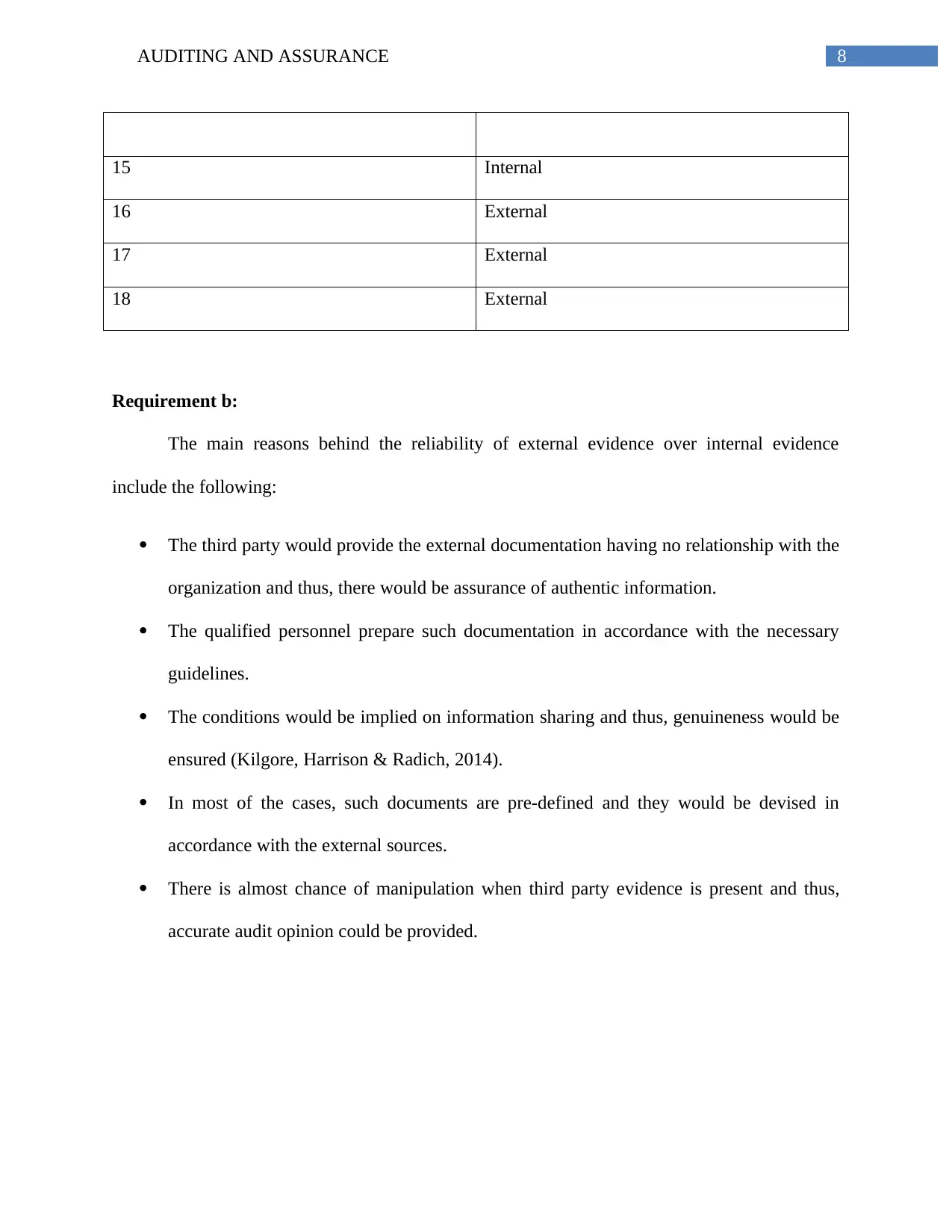
8AUDITING AND ASSURANCE
15 Internal
16 External
17 External
18 External
Requirement b:
The main reasons behind the reliability of external evidence over internal evidence
include the following:
The third party would provide the external documentation having no relationship with the
organization and thus, there would be assurance of authentic information.
The qualified personnel prepare such documentation in accordance with the necessary
guidelines.
The conditions would be implied on information sharing and thus, genuineness would be
ensured (Kilgore, Harrison & Radich, 2014).
In most of the cases, such documents are pre-defined and they would be devised in
accordance with the external sources.
There is almost chance of manipulation when third party evidence is present and thus,
accurate audit opinion could be provided.
15 Internal
16 External
17 External
18 External
Requirement b:
The main reasons behind the reliability of external evidence over internal evidence
include the following:
The third party would provide the external documentation having no relationship with the
organization and thus, there would be assurance of authentic information.
The qualified personnel prepare such documentation in accordance with the necessary
guidelines.
The conditions would be implied on information sharing and thus, genuineness would be
ensured (Kilgore, Harrison & Radich, 2014).
In most of the cases, such documents are pre-defined and they would be devised in
accordance with the external sources.
There is almost chance of manipulation when third party evidence is present and thus,
accurate audit opinion could be provided.
⊘ This is a preview!⊘
Do you want full access?
Subscribe today to unlock all pages.

Trusted by 1+ million students worldwide
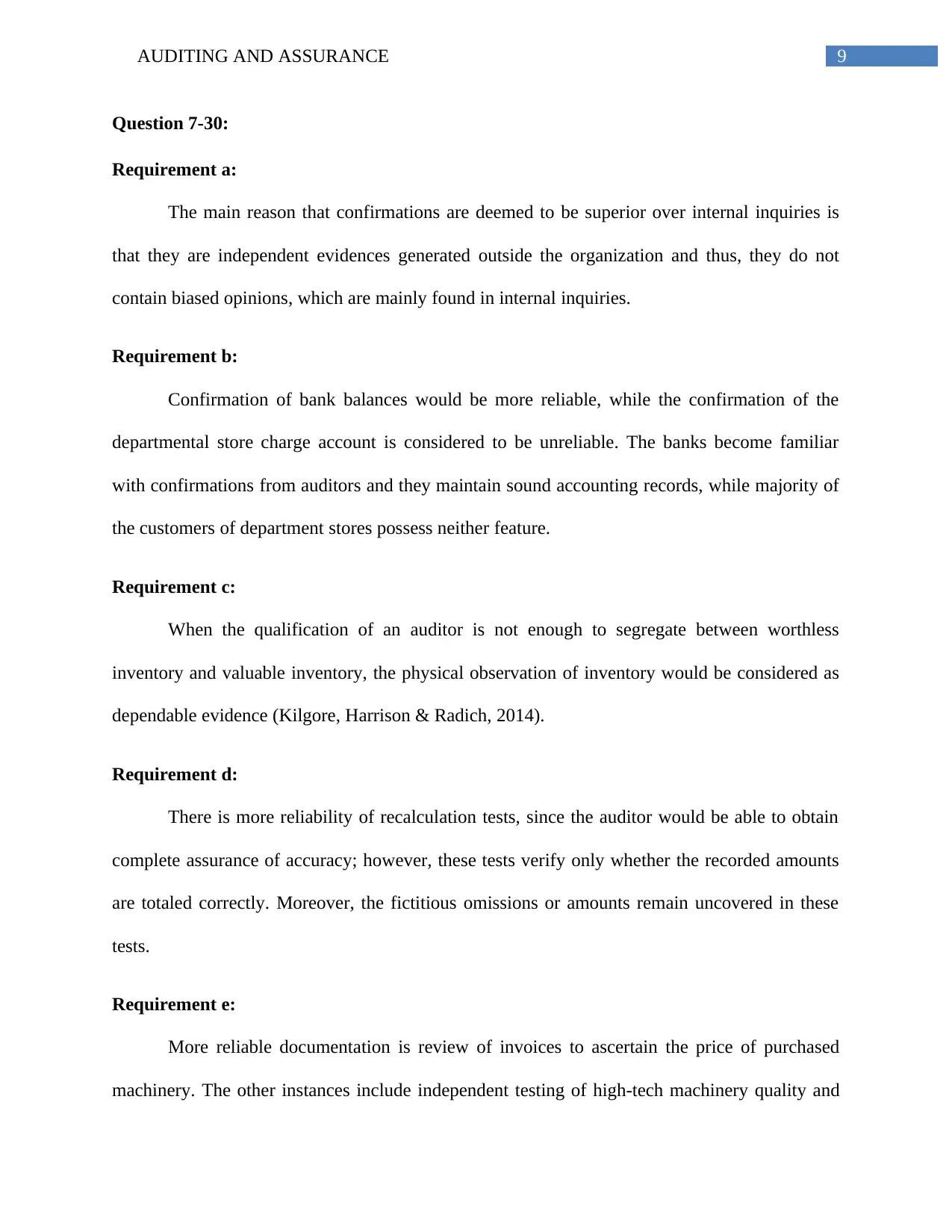
9AUDITING AND ASSURANCE
Question 7-30:
Requirement a:
The main reason that confirmations are deemed to be superior over internal inquiries is
that they are independent evidences generated outside the organization and thus, they do not
contain biased opinions, which are mainly found in internal inquiries.
Requirement b:
Confirmation of bank balances would be more reliable, while the confirmation of the
departmental store charge account is considered to be unreliable. The banks become familiar
with confirmations from auditors and they maintain sound accounting records, while majority of
the customers of department stores possess neither feature.
Requirement c:
When the qualification of an auditor is not enough to segregate between worthless
inventory and valuable inventory, the physical observation of inventory would be considered as
dependable evidence (Kilgore, Harrison & Radich, 2014).
Requirement d:
There is more reliability of recalculation tests, since the auditor would be able to obtain
complete assurance of accuracy; however, these tests verify only whether the recorded amounts
are totaled correctly. Moreover, the fictitious omissions or amounts remain uncovered in these
tests.
Requirement e:
More reliable documentation is review of invoices to ascertain the price of purchased
machinery. The other instances include independent testing of high-tech machinery quality and
Question 7-30:
Requirement a:
The main reason that confirmations are deemed to be superior over internal inquiries is
that they are independent evidences generated outside the organization and thus, they do not
contain biased opinions, which are mainly found in internal inquiries.
Requirement b:
Confirmation of bank balances would be more reliable, while the confirmation of the
departmental store charge account is considered to be unreliable. The banks become familiar
with confirmations from auditors and they maintain sound accounting records, while majority of
the customers of department stores possess neither feature.
Requirement c:
When the qualification of an auditor is not enough to segregate between worthless
inventory and valuable inventory, the physical observation of inventory would be considered as
dependable evidence (Kilgore, Harrison & Radich, 2014).
Requirement d:
There is more reliability of recalculation tests, since the auditor would be able to obtain
complete assurance of accuracy; however, these tests verify only whether the recorded amounts
are totaled correctly. Moreover, the fictitious omissions or amounts remain uncovered in these
tests.
Requirement e:
More reliable documentation is review of invoices to ascertain the price of purchased
machinery. The other instances include independent testing of high-tech machinery quality and
Paraphrase This Document
Need a fresh take? Get an instant paraphrase of this document with our AI Paraphraser
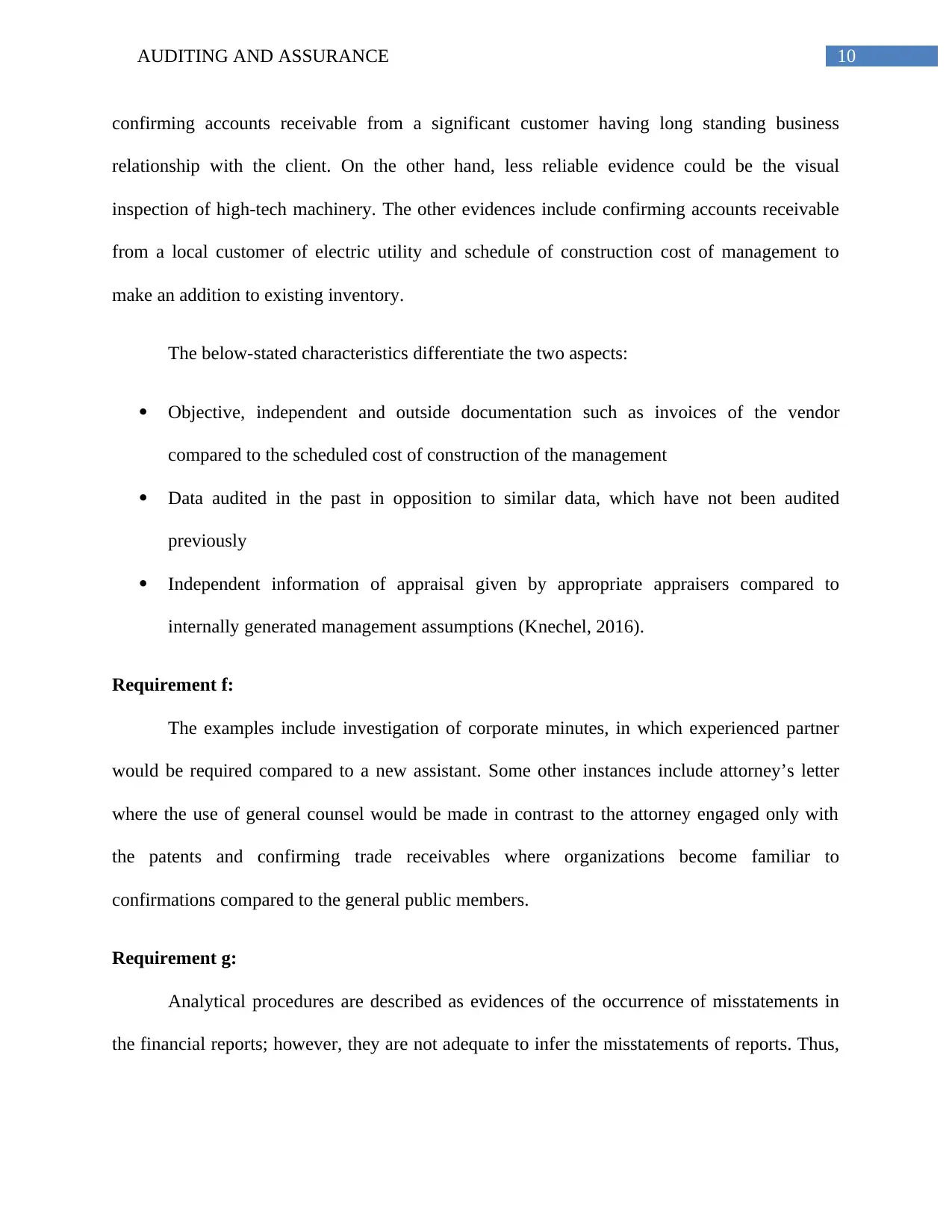
10AUDITING AND ASSURANCE
confirming accounts receivable from a significant customer having long standing business
relationship with the client. On the other hand, less reliable evidence could be the visual
inspection of high-tech machinery. The other evidences include confirming accounts receivable
from a local customer of electric utility and schedule of construction cost of management to
make an addition to existing inventory.
The below-stated characteristics differentiate the two aspects:
Objective, independent and outside documentation such as invoices of the vendor
compared to the scheduled cost of construction of the management
Data audited in the past in opposition to similar data, which have not been audited
previously
Independent information of appraisal given by appropriate appraisers compared to
internally generated management assumptions (Knechel, 2016).
Requirement f:
The examples include investigation of corporate minutes, in which experienced partner
would be required compared to a new assistant. Some other instances include attorney’s letter
where the use of general counsel would be made in contrast to the attorney engaged only with
the patents and confirming trade receivables where organizations become familiar to
confirmations compared to the general public members.
Requirement g:
Analytical procedures are described as evidences of the occurrence of misstatements in
the financial reports; however, they are not adequate to infer the misstatements of reports. Thus,
confirming accounts receivable from a significant customer having long standing business
relationship with the client. On the other hand, less reliable evidence could be the visual
inspection of high-tech machinery. The other evidences include confirming accounts receivable
from a local customer of electric utility and schedule of construction cost of management to
make an addition to existing inventory.
The below-stated characteristics differentiate the two aspects:
Objective, independent and outside documentation such as invoices of the vendor
compared to the scheduled cost of construction of the management
Data audited in the past in opposition to similar data, which have not been audited
previously
Independent information of appraisal given by appropriate appraisers compared to
internally generated management assumptions (Knechel, 2016).
Requirement f:
The examples include investigation of corporate minutes, in which experienced partner
would be required compared to a new assistant. Some other instances include attorney’s letter
where the use of general counsel would be made in contrast to the attorney engaged only with
the patents and confirming trade receivables where organizations become familiar to
confirmations compared to the general public members.
Requirement g:
Analytical procedures are described as evidences of the occurrence of misstatements in
the financial reports; however, they are not adequate to infer the misstatements of reports. Thus,
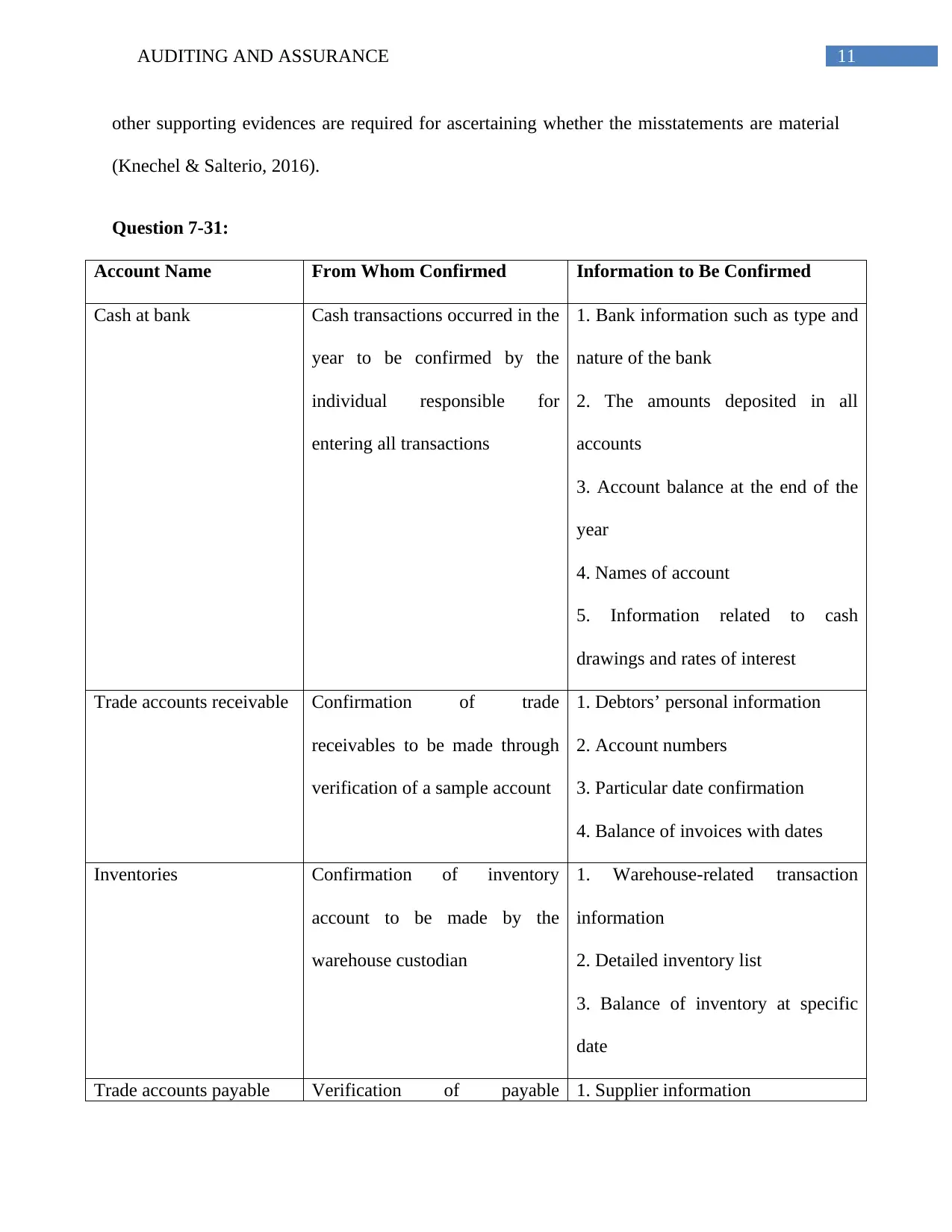
11AUDITING AND ASSURANCE
other supporting evidences are required for ascertaining whether the misstatements are material
(Knechel & Salterio, 2016).
Question 7-31:
Account Name From Whom Confirmed Information to Be Confirmed
Cash at bank Cash transactions occurred in the
year to be confirmed by the
individual responsible for
entering all transactions
1. Bank information such as type and
nature of the bank
2. The amounts deposited in all
accounts
3. Account balance at the end of the
year
4. Names of account
5. Information related to cash
drawings and rates of interest
Trade accounts receivable Confirmation of trade
receivables to be made through
verification of a sample account
1. Debtors’ personal information
2. Account numbers
3. Particular date confirmation
4. Balance of invoices with dates
Inventories Confirmation of inventory
account to be made by the
warehouse custodian
1. Warehouse-related transaction
information
2. Detailed inventory list
3. Balance of inventory at specific
date
Trade accounts payable Verification of payable 1. Supplier information
other supporting evidences are required for ascertaining whether the misstatements are material
(Knechel & Salterio, 2016).
Question 7-31:
Account Name From Whom Confirmed Information to Be Confirmed
Cash at bank Cash transactions occurred in the
year to be confirmed by the
individual responsible for
entering all transactions
1. Bank information such as type and
nature of the bank
2. The amounts deposited in all
accounts
3. Account balance at the end of the
year
4. Names of account
5. Information related to cash
drawings and rates of interest
Trade accounts receivable Confirmation of trade
receivables to be made through
verification of a sample account
1. Debtors’ personal information
2. Account numbers
3. Particular date confirmation
4. Balance of invoices with dates
Inventories Confirmation of inventory
account to be made by the
warehouse custodian
1. Warehouse-related transaction
information
2. Detailed inventory list
3. Balance of inventory at specific
date
Trade accounts payable Verification of payable 1. Supplier information
⊘ This is a preview!⊘
Do you want full access?
Subscribe today to unlock all pages.

Trusted by 1+ million students worldwide
1 out of 18
Related Documents
Your All-in-One AI-Powered Toolkit for Academic Success.
+13062052269
info@desklib.com
Available 24*7 on WhatsApp / Email
![[object Object]](/_next/static/media/star-bottom.7253800d.svg)
Unlock your academic potential
Copyright © 2020–2025 A2Z Services. All Rights Reserved. Developed and managed by ZUCOL.





